Understanding Color Temperature (Kelvin) - Static White
Static White LED lighting is one of our most popular color choices that we sell. It comes in an array of different color temperatures which are measured in Kelvins. Similar to a standard thermometer, the Kelvin scale basically gets warmer or cooler as the color temperature goes up and down. The color of the light output is determined by its placement on the temperature scale, warmer lighting has lower Kelvin rating while cooler temperatures have higher. LED Binning and the Importance of Color Consistency The LED binning process is the way that LED chips are sorted and chosen for use in the manufacturing process. A good binning process ensures that color temperatures will be the same each time the LED lighting is produced. Our trusted manufacturers use only the highest standards when creating our LED strips and lighting. SDCM(standard deviation of color matching) within three-step, IES60081:2010 standard, within the MacAdam eclipse which is stricter than ANSI recommendation tl stay within a four-step ellipse.
Color Temperature Measured in Kelvins
- Lower gets Warmer
- Higher gets Cooler
- 2700-3500K Warm Range
- 4000-4750K Daylight Range
- 5700-6500K Cool Range

Warm White (2700-3500K)


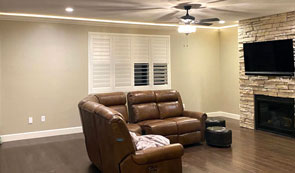
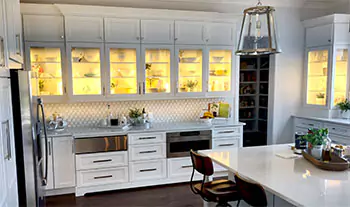
Ideal Applications
- Calm & Relaxing Environments
- Bedroom, Living Room, Bathrooms
- Wine Bar, Speak Easy, Steak House
- Enhances Natural Woods & Landscapes
Warm White LED lighting, also known as Soft White, is one of the most popular color choices for both residential and business use. The 2700-3500K temperature is the closest to a traditional incandescent style bulb and when used in a home or business setting it creates a cozy and welcoming environment. The lower end of the warm white spectrum around 1800-2700K is more of a candle light tone and used mainly for relaxing and quieter settings, while the 3000-3500K is more frequently used for everyday lighting in both home and industrial settings.
Warm White Strip Lights Warm White LED Neon Warm White Modules Warm White Fixtures
Daylight White (4000-4750K)




Ideal Applications
- Active & Stimulating Environments
- Office, Kitchen, Vanities
- Retail, Cafés, Markets
- Brings Energy and Vibrancy to Space
Daylight White LED Lighting, also known as Neutral White, is a great choice for spaces with more activity and energy than your typical relaxing environment. It is known to produce a color temperature that is closer to natural daylight which promotes activity and functionality. Much like the warmer lighting this brighter white light can be used in any interior or exterior lighting applications and is commonly used in modern homes and businesses. When used on exterior landscape lighting daylight white enhances greens of bushes and trees and creates an inviting and vibrant effect.
Daylight White Strip Lights Daylight White Modules Daylight White Fixtures
Cool White (5700-6500K)



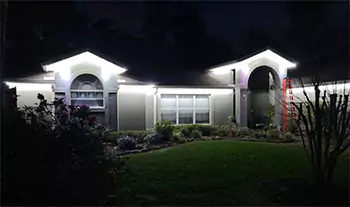
Ideal Applications
- Industrial and Work Settings
- Garages, Workshops, Pathways
- Warehouse, Hospitals, Signage
- Contrasting Accent on Dark Surfaces
Cool White LED Lighting, or Bright White as some call, is best for industrial, medical and manufacturing settings. This kelvin temperature range outputs the highest amount of lumens due to its color temperature and has a white similar to a standard white neon tube light. This lighting is commonly used in backlighting of signs and channel letters to create bright and noticeable signage. It's also common in exhibit accents and can create an eye catching contrast when used on dark stones or against vibrant colors. It can also be used in landscape lighting to create more of a bluish moonlight effect.
Cool White Strip Lights Cool White LED Neon Cool White Modules Cool White Fixtures
Related Categories
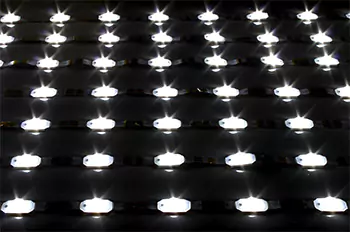 Static White LED Sign Modules | 3,000K-6,500K Color Temperature
Static White LED Sign Modules | 3,000K-6,500K Color Temperature
Use our cool white, daylight white, or warm white LED modules in your signs and displays. Single color one, two, three and four chip module lighting ranging from 3,000-6,500K.
 PWM LED Dimmers & Switches
PWM LED Dimmers & Switches
PWM (Pulse Width Modulation) LED Light Dimmers, give your LED Lighting products the ability to dim using a variety of control options. We have several types of LED Dimmers including basic knob style LED Dimmers, slider style LED Dimmers, wall mount dimmers for your LED lights, RF Remote style LED dimming control, zone dimmers, and WiFi dimmers. We also have a variety of on/off sensor switches for custom LED projects. Give us a call if you have any questions about what LED dimmer is best for your LED application.
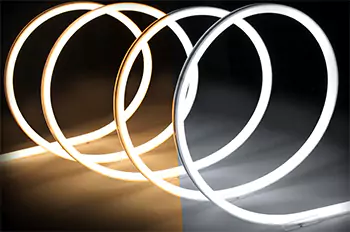 Static White LED Neon - Cool, Natural & Warm
Static White LED Neon - Cool, Natural & Warm
Static White LED Neon is a dot free single color linear LED light in various color temperatures ranging from 2700-6500K. Our warm white LED Neon is in the 3000K range and ideal for more relaxing and soothing environments, while our neutral white neon is in the 4500K range and ideal for more active and modern environments, lastly our cool white LED neon is in the 6000K range and is ideal for displays, attractive accent lighting and mixes well with colored lighting to create high contrast appeal.
 Static White Strip Lights - Cool, Neutral & Warm
Static White Strip Lights - Cool, Neutral & Warm
Our single color static white strip lights have a single color, dimmable white output, ranging from warm to cool on the kelvin color temperature scale. For calm & relaxing environments like bedrooms, living rooms or intimate business settings our Warm White (2700-3500K) is most preferred. For more active & stimulating environments such as offices, kitchens and retail settings our Neutral White (4000-4750K) is the color temperature most desired. Lastly our Cool White (5700-6500K) single color strips are best for Industrial and work settings like workshops, hospitals, signage and displays.